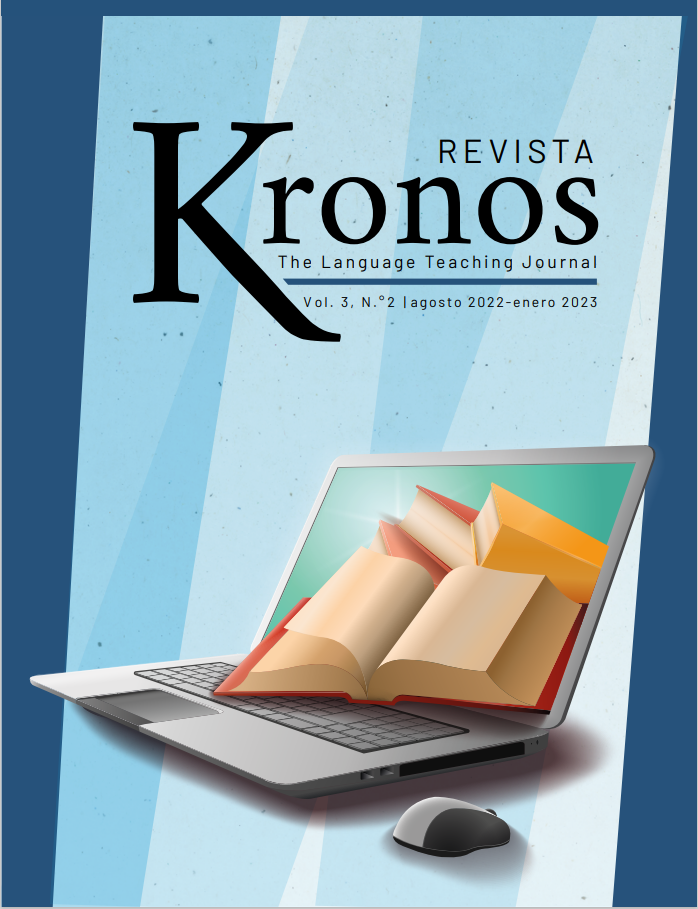Educational escape room as a gamification strategy for improving oral skills in the English language
DOI:
https://doi.org/10.29166/kronos.v3i2.3741Keywords:
games, communication, educationAbstract
Modern education tends to be more flexible and with a variety of strategies that permit learners to develop and propel their language skills. In this regard, the implementation of educational escape rooms are necessary to be accord with these days’ demands. The present study aims to identify the functionality and applicability of some games in schools and in different settings that support the improvement of the students’ communicative skills. In this way, a mixed-method with a control and experimental group that includes qualitative and quantitative data, observation and a survey permit to understand the students´ needs and their perceptions regarding the use of games to enhance their language skills. In addition, it shows the importance to relate and match accurately the language topics with specific games. The most important results show that students are eager to learn by playing and the significance of working in different environments that permit students to change their traditional learning. It is also essential to include that even though traditional games are appealing for young learners, the use of technology and internet connection turned into a powerful tool of motivation and engagement for students.
As a conclusion, it was evidenced that modifying the teaching way produces high commitment among students and their curiosity influences to develop positive interaction and communicative skills.
Downloads
References
Ang, J. W. J., Ng, Y. N. A., & Liew, R. S. (2020). Physical and digital educational escape
room for teaching chemical bonding. Journal of Chemical Education, 97(9), 2849-2856.
https://doi.org/10.1021/acs.jchemed.0c00612
Cruz, M. (2019). Escaping from the traditional classroom. The ‘escape room methodology’ in the foreign languages classroom. Babylonia, Rivista svizzera per l’insegnamento
delle lingue, 3, 26-29. http://hdl.handle.net/10400.22/15187
Dicheva, D., Dichev, C., Agre, G., & Angelova, G. (2015). Gamification in education: a
systematic mapping study. Journal of Educational Technology & Society, 18(3), 75-88.
https://www.jstor.org/stable/jeductechsoci.18.3.75
Egan, J. D., Banter, J. N., & Sorgen, C. H. (2021). Assessing escape rooms as a teaching
strategy for leadership competency development. Journal of leadership Education, 20(1).
https://journalofleadershiped.org/wp-content/uploads/2020/12/20_1_eganD.pdf
Eukel, H., & Morrell, B. (2021). Ensuring educational escape-room success: The process
of designing, piloting, evaluating, redesigning, and re-evaluating educational escape
rooms. Simulation & Gaming, 52(1), 18-23. https://doi.org/10.1177/1046878120953453
Fotaris, P. & Mastoras, T. (2019, october). Escape rooms for learning: A systematic review.
In Proceedings of the European Conference on Games Based Learning (pp. 235-243).
https://core.ac.uk/download/pdf/232941342.pdf
Gunawardena, M. & Brown, B. (2021). Fostering values through authentic storytelling. Australian Journal of Teacher Education (Online), 46(6), 36-53. https://search.
informit.org/doi/abs/10.3316/informit.045067489909904
Hasbi, M., Munawir, A., Ahmad, G., & Khair, U. (2022). Teaching vocabulary using games:
empowering students’ interest in elt classrooms. patikala: Journal Pengabdian Kepada
Masyarakat, 1(3), 155-160. https://etdci.org/journal/patikala/article/view/290
Jabeen, S. S. (2014). Implementation of communicative approach. English Language
Teaching, 7(8), 68-74. https://doi.org/10.5539/elt.v7n8p68
Konomi, D. K. (2014, March). Using visual materials in teaching vocabulary in English as a
foreign language classrooms with young learners. In Proceedings of the international conference on new perspectives in science education (pp. 256-260). Padova: Webster. https://
conference.pixel-online.net/NPSE/files/npse/ed0003/FP/0311-SERA209-FP-NPSE3.pdf
López-Pernas, S., Gordillo, A., Barra, E., & Quemada, J. (2019). Analyzing learning effectiveness
and students’ perceptions of an educational escape room in a programming course in higher
education. ieee Access, 7, 184221-184234. https://doi.org/10.1109/ACCESS.2019.2960312
Martens, S. & Crawford, K. (2019). Embracing wonder and curiosity: Transforming teacher practice through escape room design. Childhood Education, 95(2), 68-75. https://
doi.org/10.1080/00094056.2019.1593764
Medina, E. G. L. & Hurtado, C. P. R. (2017). Kahoot! A digital tool for learning vocabulary
in a language classroom. Revista Publicando, 4 12(1), 441-449. https://revistapublicando.org/revista/index.php/crv/article/view/673
Mokhtar, N. H., Halim, M. F. A., & Kamarulzaman, S. Z. S. (2011). The effectiveness
of storytelling in enhancing communicative skills. Procedia-Social and Behavioral
Sciences, 18(1), 163-169. https://doi.org/10.1016/j.sbspro.2011.05.024
Moura, A. & Santos, I. L. (2019). Escape room in education: gamify learning to engage students
and learn maths and languages. Experiences and perceptions of pedagogical practices with, 179.
Mudure-Iacob, I. (2021). Hide and Seek in gamified learning: Formative assessment of
esp in digital escape rooms. Astra Salvensis-revista de istorie si cultura, 9(17), 209-217.
Nicholson, S. (2018). Creating engaging escape rooms for the classroom. Childhood
Education, 94(1), 44-49. https://doi.org/10.1080/00094056.2018.1420363
Papadopoulos, I. & Tenta, E. (2021). Escape rooms as a collaborative problem-solving environment. International Journal of Game-Based Learning (ijgbl), 11(4), 57-71. https://
doi.org/10.4018/IJGBL.2021100103
Pho, A. & Dinscore, A. (2015). Game-based learning. Tips and trends, 1(1), 1-5. https://
acrl.ala.org/IS/wp-content/uploads/2014/05/spring2015.pdf
Some-Guiebre, E. (2020). Foreign language classroom interaction: Does it promote communicative skills? International Journal of Educational Methodology, 6(3), 497-505.
https://doi.org/10.12973/ijem.6.3.497
Taraldsen, L. H., Haara, F. O., Lysne, M. S., Jensen, P. R., & Jenssen, E. S. (2020). A review
on use of escape rooms in education-touching the void. Education Inquiry, 13(2), 169-
https://doi.org/10.1080/20004508.2020.1860284
Tietze, K. J. (2007). A bingo game motivates students to interact with course material. American
journal of pharmaceutical education, 71(4). https://doi.org/10.5688/aj710479
Urbieta, A. S. & Peñalver, E. A. (2019). Escaping from the English classroom. Who will get out
first? Aloma: revista de psicologia, ciències de l’educació i de l’esport Blanquerna, 37(2), 83-92.
Veldkamp, A., Daemen, J., Teekens, S., Koelewijn, S., Knippels, M. C. P., & van Joolingen, W.
R. (2020). Escape boxes: Bringing escape room experience into the classroom. British
Journal of Educational Technology, 51(4), 1220-1239. https://doi.org/10.1111/bjet.12935
Vidergor, H. E. (2021). Effects of digital escape room on gameful experience, collaboration,
and motivation of elementary school students. Computers & Education, 166, 104156.
https://doi.org/10.1016/j.compedu.2021.104156
Williamson, B. (2009). Computer games, schools, and young people: a report for educators on using games for learning. Futurelab
Published
How to Cite
Issue
Section
License
Copyright (c) 2022 Jonathan Suntaxi Llumiquinga

This work is licensed under a Creative Commons Attribution-NonCommercial-ShareAlike 4.0 International License.












